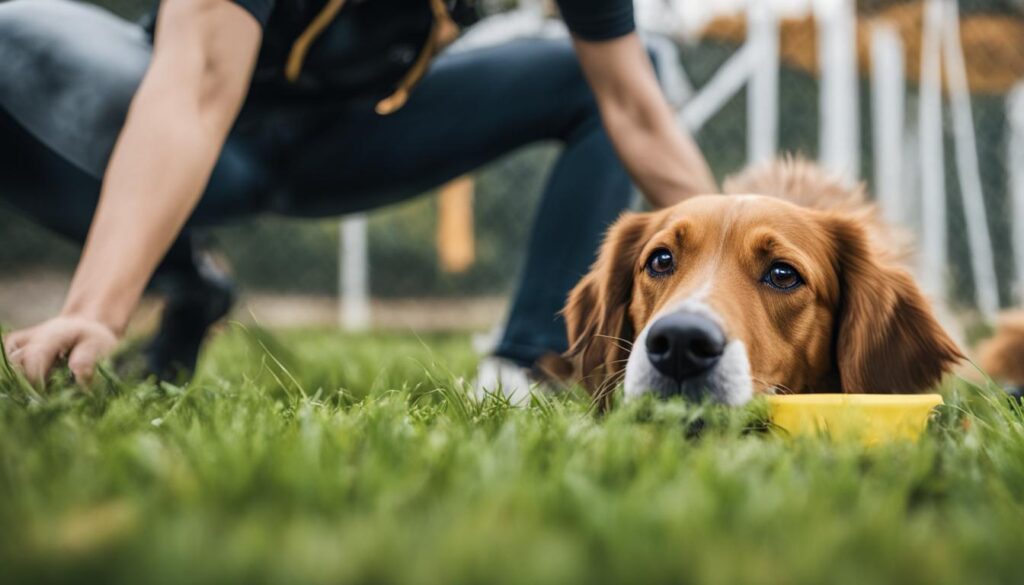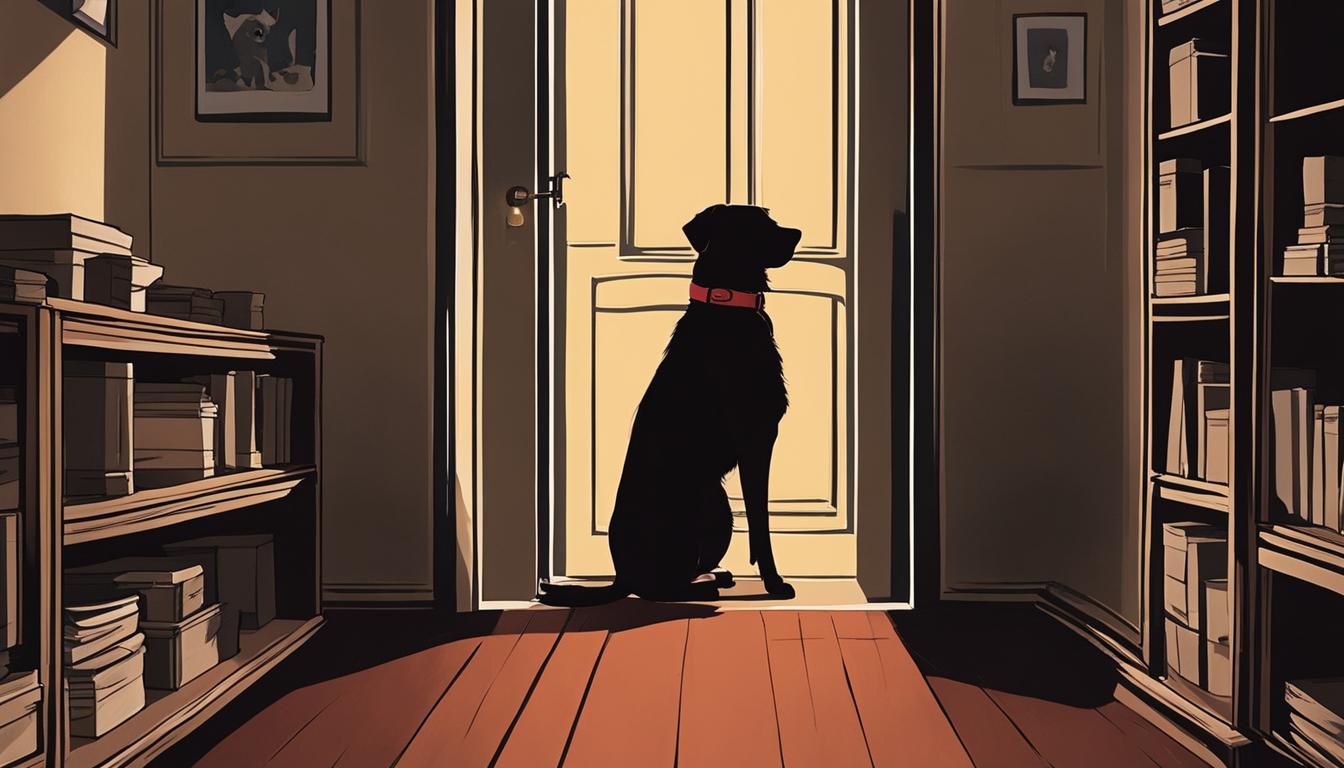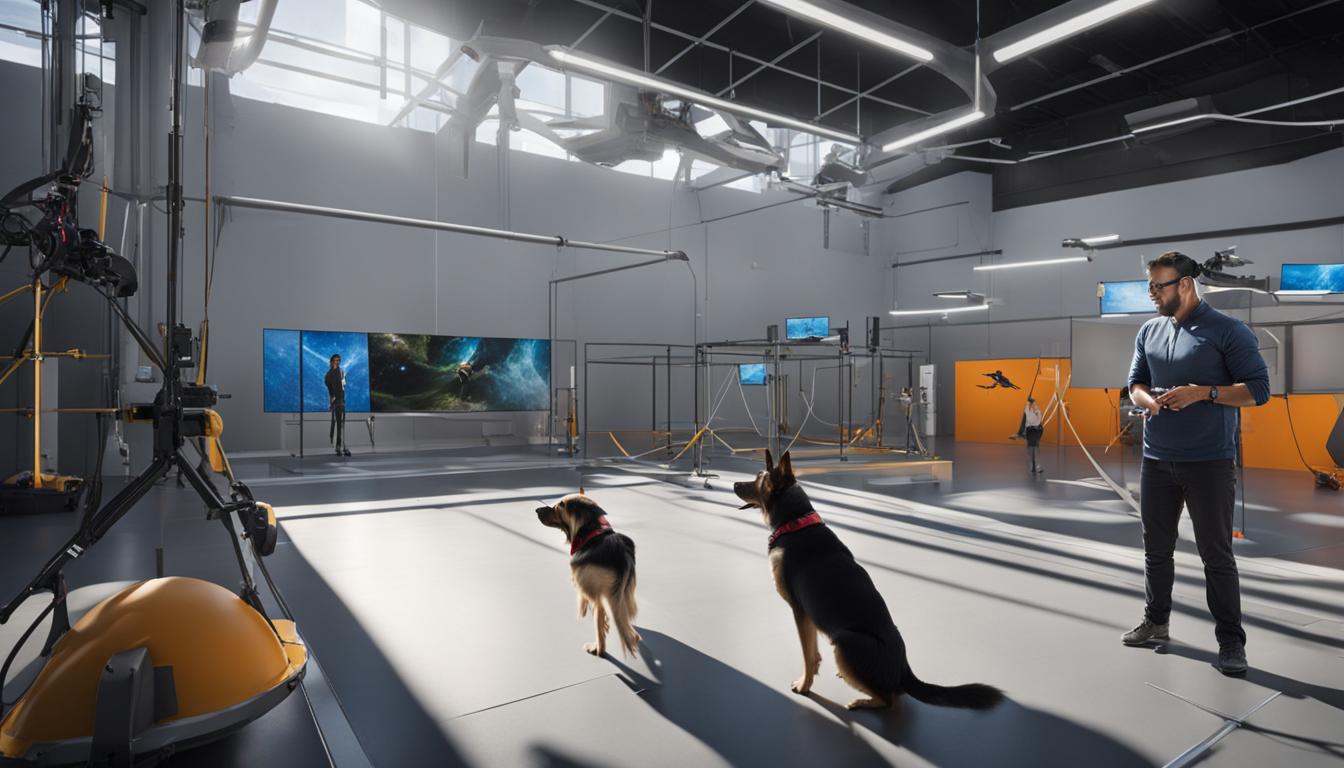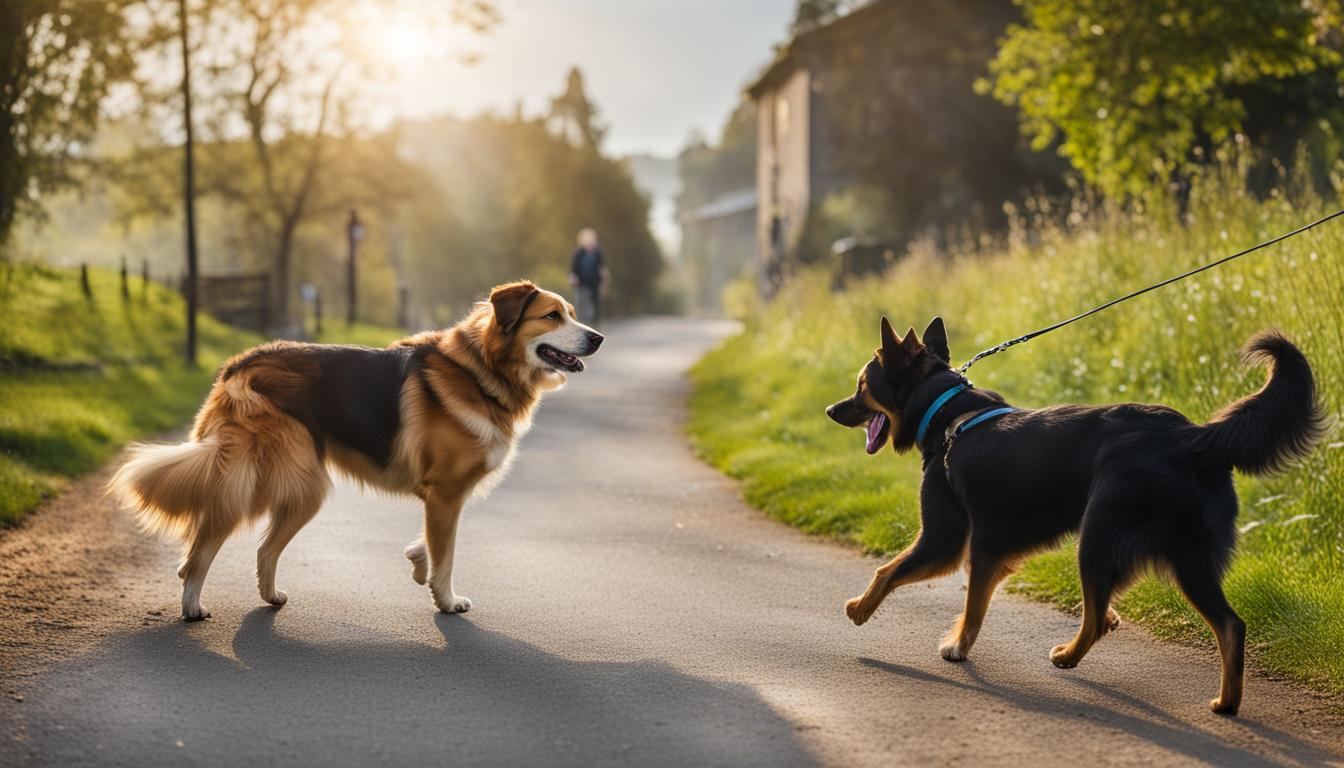Training dogs with fear and anxiety can present unique challenges for dog owners. It’s important to understand how to address and manage these emotions in order to create a positive and effective training environment for your furry friend. By employing techniques that focus on calming fearful dogs and building their confidence, you can help them overcome their fears and become happier, more well-adjusted companions.
We all know that some dogs can be nervous or anxious around certain situations or stimuli. Whether it’s the presence of strangers, other dogs, or loud noises, their anxiety can make training sessions difficult. But fear not! With the right knowledge and techniques, you can address your dog’s anxiety and create a safe and supportive training environment. Let’s explore some effective strategies for calming fearful dogs and helping them overcome their fears.
Key Takeaways:
- Recognize the early warning signs of anxiety and fear in your dog, such as yawning, disinterest, panting, sniffing, growling, or lunging.
- Respect your dog’s emotional state and avoid training sessions when they are in a fearful state.
- Build your dog’s confidence through routines, basic obedience training, and engaging in dog sports.
- Understand the causes of fear and anxiety in dogs, including separation from their mother too early and traumatic experiences.
- Implement desensitization and counterconditioning techniques to help your dog overcome their fears in a controlled and safe manner.
Understanding the Causes of Fear and Anxiety in Dogs
When it comes to training anxious dogs, it’s essential to understand the underlying causes of their fear and anxiety. Several factors can contribute to these emotions, and by identifying them, we can create effective training approaches that focus on building confidence and overcoming fear.
One of the common causes of fear and anxiety in dogs is early separation from their mother. Puppies that are separated too soon may develop insecure attachment styles, leading to heightened anxiety in various situations. Additionally, mismanagement of fear phases during puppy development and poor breeding practices can also contribute to fear and anxiety in dogs.
Other factors such as abandonment, previous trauma or injury, lack of clarity about the environment, and frustration from leash and collar usage can further exacerbate fear and anxiety. Recognizing these causes allows us to tailor our training techniques to address the specific needs of anxious dogs and help them overcome their fears.

Causes of Fear and Anxiety in Dogs
| Cause | Description |
|---|---|
| Early Separation | Separation from mother too soon can lead to insecure attachment and heightened anxiety. |
| Mismanaged Fear Phases | Failure to address fear phases during puppy development can contribute to fear and anxiety later in life. |
| Poor Breeding Practices | Irresponsible breeding can result in genetic predispositions to fear and anxiety in dogs. |
| Abandonment | Dogs that have been abandoned may experience heightened anxiety due to past traumas. |
| Trauma and Injury | Previous traumatic experiences or injuries can trigger fear and anxiety in dogs. |
| Lack of Clarity | Uncertainty about the environment and inconsistent guidance can contribute to fear and anxiety. |
| Frustration from Leash and Collar | Difficulty with leash and collar usage can lead to frustration and increased anxiety. |
By understanding the causes of fear and anxiety in dogs, we can approach training with empathy and compassion. Tailoring our techniques to address these underlying factors will not only help build confidence in fearful dogs but also provide them with the tools they need to overcome their fears and thrive in training sessions.
Managing Anxiety During Dog Training
When it comes to training skittish dogs, managing anxiety is crucial for their progress and overall well-being. By understanding the emotional states of dogs and employing specific training techniques, you can help reduce stress and create a positive training environment.
The Emotional States of Dogs
Dogs, just like humans, experience emotions such as fear and anxiety. These emotions are controlled by the limbic system in their brains, which regulates their responses to various stimuli. Understanding how fear and anxiety manifest in dogs can guide your training approach and help you address their specific needs.
Dogs may display various behaviors when they are anxious, such as biting, barking excessively, hiding, trembling, or even exhibiting signs of learned helplessness. Recognizing these signs will allow you to identify when your dog is feeling stressed or fearful during training sessions.
Quote: “Recognizing the signs of anxiety in dogs is the first step in effectively managing their emotional well-being during training.” – Professional Dog Trainer
Training Techniques for Skittish Dogs
Reducing stress in dog training sessions is essential for skittish dogs. One effective technique is gradual desensitization. This involves exposing the dog to the trigger of their fear in a controlled and gradual manner, starting with a low level of intensity. By slowly increasing the exposure while ensuring the dog remains calm, you can help them overcome their fears.
Another technique is counterconditioning, which aims to change the dog’s emotional response to the trigger by associating it with positive experiences. For example, if your dog is fearful of strangers, you can reward them with treats when they calmly approach a stranger. This helps build a positive association with the trigger, reducing their anxiety over time.
Remember, patience and positive reinforcement are crucial when training skittish dogs. Each dog is unique, and progress may take time. By creating a supportive and stress-free training environment, you can help your dog build confidence and conquer their fears.
| Training Techniques for Skittish Dogs | Benefits |
|---|---|
| Gradual desensitization | – Helps dogs overcome fears – Builds resilience and confidence |
| Counterconditioning | – Changes emotional response to triggers – Creates positive associations |
| Patience and positive reinforcement | – Builds trust and rapport – Encourages desired behaviors |
Desensitization and Counterconditioning
Desensitization and counterconditioning are powerful techniques that can help fearful dogs overcome their anxieties and fears. These behavior modification methods involve gradually exposing the dog to the feared stimulus at a low level while simultaneously pairing it with something positive, such as treats or praise. Through systematic exposure and positive association, desensitization and counterconditioning can help dogs build new, positive associations and reduce their fear responses.
Desensitization involves exposing the dog to the feared stimulus in a controlled and gradual manner. The goal is to start at a level where the dog feels comfortable and relaxed, and then slowly increase the intensity or proximity of the stimulus over time. For example, if a dog is afraid of loud noises, the desensitization process may begin by playing a low volume recording of the noise and gradually increasing the volume as the dog becomes more comfortable.
Counterconditioning is the simultaneous pairing of the feared stimulus with something positive. This technique aims to change the dog’s emotional response to the stimulus by associating it with something enjoyable. For instance, if a dog is fearful of strangers, counterconditioning may involve having strangers approach the dog while offering high-value treats. Over time, the dog will learn to associate the presence of strangers with positive experiences and may become less fearful as a result.
| Desensitization and Counterconditioning in Action | Benefits |
|---|---|
| “Playing a low volume recording of the noise and gradually increasing the volume as the dog becomes more comfortable.” | The dog learns to tolerate and eventually overcome fear-inducing stimuli. |
| “Having strangers approach the dog while offering high-value treats.” | The dog forms positive associations with previously feared stimuli. |
| “Pairing the sight of other dogs with playtime and rewards.” | The dog’s fear of other dogs diminishes as positive associations are formed. |
It is important to note that desensitization and counterconditioning should be done at the dog’s own pace and with careful consideration for their comfort and well-being. Pushing the dog too quickly or overwhelming them can lead to heightened anxiety and setbacks in the training process. Consulting with a professional dog trainer or animal behaviorist can provide guidance and support in implementing these techniques effectively. With patience, consistency, and positive reinforcement, desensitization and counterconditioning can be powerful tools in helping fearful dogs overcome their fears and thrive in training sessions.
Building Resilience in Anxious Dogs: Coping Strategies for Fearful Dogs in Training
If you have a fearful dog, helping them build resilience and cope with their fears is essential for their well-being. By implementing the right coping strategies during training sessions, you can empower your anxious dog and make progress towards overcoming their fears. Here are some effective techniques:
Socialization Exercises
Socializing your fearful dog with calm and friendly dogs can help them gain confidence and reduce anxiety. Arrange controlled playdates or enroll in structured socialization classes to provide positive interactions in a controlled environment. Gradually expose your dog to new and safe experiences, ensuring they feel secure throughout the process.
Positive Reinforcement
Using positive reinforcement techniques, such as treats, praise, and play, can help your fearful dog associate training sessions with positive experiences. Rewarding desirable behaviors encourages your dog to repeat them and builds their confidence. Remember to be patient and consistent, rewarding small steps towards progress.
Creating Safe Spaces
Designate a quiet and comfortable area in your home where your fearful dog can retreat when they feel anxious. Provide cozy bedding, toys, and a sense of security in this safe space. Make it a positive environment by incorporating calming scents, soft lighting, and soothing music. Encouraging your dog to use their safe space when they feel overwhelmed can help them self-regulate and reduce stress.
| Fear Triggers | Coping Strategies |
|---|---|
| Loud Noises | Use white noise machines or calming music to mask the sounds and create a soothing environment. Gradually introduce the noises in a controlled manner using desensitization techniques. |
| Strangers | Teach your dog polite greetings and reward calm behavior around strangers. Gradually introduce new people in a positive way, ensuring your dog feels safe and comfortable throughout the process. |
| Leash Reactivity | Practice loose leash walking and reward your dog for calm behavior. Use counterconditioning techniques by pairing the presence of other dogs or stimuli with positive experiences. |
Remember, building resilience in anxious dogs takes time and patience. Seek guidance from a professional dog trainer or behaviorist who specializes in fearful dogs to develop a personalized training plan for your furry friend. With the right strategies and consistent effort, you can help your anxious dog navigate their fears and build the confidence they need to thrive.

References:
- Smith, J. (2020). Helping Fearful Dogs Build Resilience. Retrieved from https://www.dogtraininginstitute.com/building-resilience-in-fearful-dogs
- Miller, P. (2019). Coping Strategies for Fearful Dogs. Retrieved from https://www.petmd.com/dog/coping-strategies-fearful-dogs
Controlling the Intensity of Stimuli
When training skittish dogs, it is essential to control the intensity of the stimuli to reduce stress and anxiety. By managing the distance, volume, and speed of the trigger, you can create a more comfortable environment for your dog to learn and overcome their fears.
One effective technique is to adjust the distance from the trigger. Start at a distance where your dog is comfortable and gradually decrease the distance over time. This gradual approach allows your dog to acclimate to the trigger and build confidence at their own pace.

Another method is to modify the volume or speed of the trigger. For example, if your dog is fearful of loud noises, you can start by playing a softer version of the sound and gradually increase the volume as your dog becomes more comfortable. Similarly, if your dog is afraid of fast-moving objects, you can begin with slower movements and gradually increase the speed.
Breaking the trigger into smaller components is also beneficial for skittish dogs. By introducing the trigger in manageable chunks, you can prevent overwhelming your dog and allow them to process the information more easily. For example, if your dog is fearful of strangers, you can start by introducing them to one stranger at a time before gradually increasing the number of people.
Remember, the key is to go at your dog’s pace and ensure they are calm and stress-free throughout the training session. Pushing your dog too fast or exposing them to intense stimuli can worsen their anxiety. Patience and gradual progression are key to helping your skittish dog overcome their fears and build confidence.
Table: Gradual Exposure to Trigger
| Training Step | Distance from Trigger | Duration of Exposure |
|---|---|---|
| Step 1 | 10 feet | 5 minutes |
| Step 2 | 8 feet | 10 minutes |
| Step 3 | 6 feet | 15 minutes |
| Step 4 | 4 feet | 20 minutes |
| Step 5 | 2 feet | 30 minutes |
Incorporating these techniques into your training sessions can greatly reduce stress and anxiety for your skittish dog. Remember to always prioritize your dog’s well-being and make adjustments as needed to ensure their comfort and success in overcoming their fears.
Tips for Successful Training
Training skittish dogs can be a challenging but rewarding experience. By using effective techniques and reducing stress in training sessions, you can help your dog build confidence and overcome their fears. Here are some tips to ensure successful training:
1. Use Positive Reinforcement
Positive reinforcement is key when training skittish dogs. Reward your dog with treats, praise, and affection for desired behaviors. This will motivate them to repeat these behaviors and build positive associations with training sessions. Avoid punishment, as it can increase stress and make fear worse.
2. Be Patient and Go at Their Pace
Skittish dogs may need more time to feel comfortable in training situations. Be patient and don’t rush the process. Start with small steps and gradually increase difficulty. If your dog shows signs of stress or fear, take a step back and make the training easier. It’s important to respect their limits and not push them too far too soon.
3. Teach Nose Targeting
Nose targeting is a useful skill that can redirect your dog’s focus and behavior. Training your dog to touch their nose to your hand, a target stick, or an object can help them feel more confident and engaged. It also provides a positive outlet for their energy and can be a helpful tool in redirecting their attention.
Remember, every dog is unique, and what works for one may not work for another. It’s important to tailor your training approach to your dog’s individual needs and personality. If you’re struggling to make progress or feel overwhelmed, consider seeking guidance from a professional dog trainer or animal behaviorist. With patience, consistency, and the right techniques, you can help your skittish dog overcome their fears and thrive in their training sessions.

| Technique | Pros | Cons |
|---|---|---|
| Desensitization and Counterconditioning | – Gradually helps dogs overcome fears – Builds positive associations – Allows control over the intensity |
– Requires time and dedication – May not work for all dogs – Requires careful planning and execution |
| Response Substitution | – Replaces unwanted behaviors – Promotes positive reinforcement – Builds resilience in dogs |
– Requires consistent training – Can be challenging to teach new behaviors – May not work for all dogs |
| Controlling the Intensity of Stimuli | – Allows gradual exposure to triggers – Provides a safe and controlled environment – Reduces stress and anxiety |
– Requires careful management – May take time for desired results – Can be challenging in real-world situations |
Conclusion
Training your dog with fear and anxiety can be a challenging but rewarding journey. By utilizing coping strategies and understanding your dog’s emotional state, you can help them overcome their fears and build confidence. Remember, patience and positive reinforcement are key.
Respecting your dog’s emotional state is crucial in creating a safe training environment. By recognizing early warning signs of anxiety and fear, such as panting or growling, you can modify the situation and help your dog cope better.
Desensitization and counterconditioning techniques are powerful tools in overcoming fear and anxiety. Gradually exposing your dog to the feared stimulus and pairing it with positive experiences can help them build positive associations and alleviate their fears.
Lastly, always remember to seek guidance from a professional dog trainer or animal behaviorist. Their expertise and support can make a significant difference in the training process. With dedication and the right strategies, you can help your fearful dog become a confident and happy companion.
FAQ
What are some early warning signs of anxiety and fear in dogs?
Early warning signs of anxiety and fear in dogs can include yawning, disinterest, panting, sniffing, growling, or lunging.
What factors can contribute to fear and anxiety in dogs?
Several factors can contribute to fear and anxiety in dogs, such as separating a puppy from its mother too early, mismanagement of fear phases during puppy development, poor breeding practices, abandonment, trauma and injury, lack of clarity about the environment, and frustration from leash and collar.
How can desensitization and counterconditioning help fearful dogs?
Desensitization involves gradually exposing the dog to the feared stimulus at a low level, while counterconditioning pairs the feared stimulus with something positive, such as treats. These techniques can help dogs build positive associations and overcome their fears.
What is response substitution in dog training?
Response substitution is the process of replacing an unwanted behavior with a more desirable one. For example, teaching a dog to sit instead of jump up or go to their bed instead of bark at the mailman.
How can you control the intensity of stimuli during training sessions for fearful dogs?
You can control the intensity of stimuli by managing the distance from the trigger, adjusting the volume or speed of the trigger, or breaking the trigger into smaller components. Gradually increasing the intensity while ensuring the dog remains calm and stress-free can help them overcome their fears.
What should I keep in mind when training a fearful dog?
When training a fearful dog, it’s important to use positive training methods, be patient, and go at the dog’s pace. Setting unrealistic expectations can lead to frustration. Teaching dogs to nose target can also be helpful in redirecting their focus and behavior.
How do I train my fearful dog to overcome fear and anxiety?
Training dogs with fear and anxiety requires patience, understanding, and positive reinforcement. By respecting a dog’s emotional state, using techniques like desensitization and response substitution, and focusing on building confidence, you can help your fearful dog overcome their fears and live a happier, healthier life.
Where can I find professional guidance and support for training my fearful dog?
It’s important to consult a professional dog trainer or animal behaviorist for guidance and support throughout the training process. They can provide you with personalized strategies and advice to address and manage your dog’s fear and anxiety.





